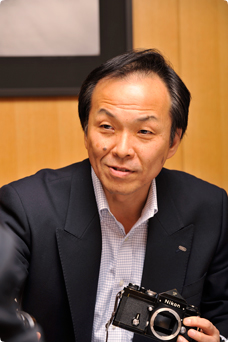Imaging Product R & D Laboratory Launched in 2009
What is the most important aspect of photography?

You’ve played a crucial role in the successful development of new cameras at the development division of Nikon Imaging Company. In 2009, you became a Nikon Fellow and launched the Imaging Product R & D Laboratory. What is the primary goal of your laboratory?
The primary goal of the lab is to analyze Nikon’s DNA so we can develop and maintain it. We also examine the value of Nikon’s presence in the market, consider what products and technologies are truly Nikon, and apply what we find to new product development.
Do you, yourself, get involved directly in product development?
No, I don’t. Nikon Imaging Company has an organization that is dedicated to planning the development of new products for the market, based on a long-term Company schedule. Each member, being fully aware of the extremely competitive nature of the camera industry, is thoroughly committed to this aim. In the development of new products, there is always the risk of some left luggage, one might say, that is easily overlooked. My task is to provide advice so that the organization is able to avoid such risks.
What is this risk, or so-called left luggage?
Another way to describe it is succession product syndrome. In creating new products, the developers’ attention tends to become overly focused on the immediate competition, with the aim of, for example, improving specifications, increasing the number of pixels or automatic multiple focus points on the screen. We need such improvements as part of our product line, of course, but this kind of development plan will not result in a camera that is truly worthy of the name Nikon.
Do you mean that new products must always offer new functions?
New functions alone are not enough. Nikon has been providing new functions such as face-priority AF, wireless transfer and a built-in projector with its cameras, ahead of the competition. And we need to continue these efforts. But sometimes they serve mainly to attract the consumers’ attention. If I was to put it another way, these are the sorts of functions that might be provided not only by Nikon, but by many others as well. Other manufacturers could also introduce them shortly afterwards, easily superseding ours in a flash. We need to maintain our efforts to produce new functions, but the pursuit of improvements in specifications and features alone should not be regarded as part of the Nikon DNA. Our mission at the Imaging Product R & D Laboratory is to discover what it is that Nikon must never forget. We then ask the younger developers about the most important factors that Nikon may have overlooked, and propose our ideas.
